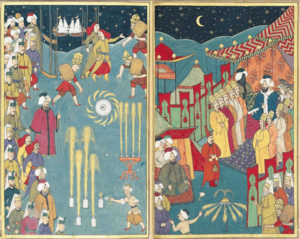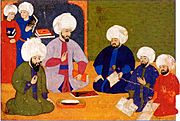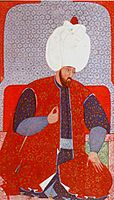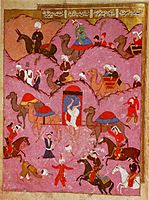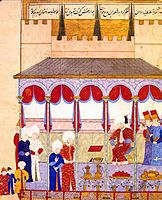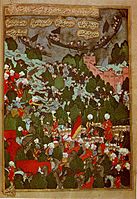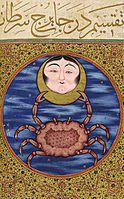Nakkaş Osman facts for kids
Quick facts for kids
Nakkaş Osman
|
|
|---|---|
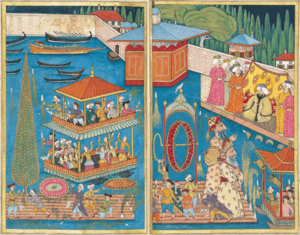
The Surname-i Hümayun parade as illustrated by Nakkaş Osman.
|
|
| Known for | Ottoman miniature |
Nakkaş Osman (sometimes called Osman the Miniaturist) was a very important miniaturist in the Ottoman Empire. He worked during the second half of the 1500s. We don't know exactly when he was born or died. But most of his amazing artworks are from the last 25 years of the 16th century.
Osman's oldest known drawings were made between 1560 and 1570. These were for a Turkish version of a famous Persian poem called Shahnama by Ferdowsi. He was the main artist for many official history books written by Sayyid Lokman. These books were made for Sultan Murad III. Some of these important books include the Zafername (which means Book of Victories). He also worked on the Şahname-ı Selim Han (Book of Kings of Sultan Selim Khan). Another big project was the Şehinşahname (Book of the King of Kings).
In 1582, Osman helped illustrate the astrological book Book of Felicity. Around 1585, he was one of the artists for the Siyer-i Nebi. This was a long story about the life of Muhammad, written around 1388.
Osman's Art Style
People describe Osman's art style as "simple, yet very smart." His drawings show great care for even the smallest details. He liked to show events in a very realistic way, almost like a photograph.
Osman's portraits often showed more feelings than those by earlier court artists. For example, there's a famous story about Rostam and Sohrab. In older paintings, the characters around them looked distant and didn't show much emotion. But in Osman's version, Sohrab's groom looks like he is "collapsing with sadness and shock." This happens as he watches Rostam accidentally kill his own son.
Osman's work was very important and influenced many artists who came after him. The best artworks from that time were often inspired by his unique style.
Osman in Books
The famous writer Orhan Pamuk, who won a Nobel Prize, wrote a novel called My Name Is Red. This book tells a fictional story about Osman and his art workshop. In the story, Osman blinds himself with a needle. This is like a legendary miniaturist named Bihzad who was also blind. In the novel, Osman's death represents "the end of the Ottoman miniature" art style. This is because after him, artists started to follow Western art ideas more.
Miniature Paintings
-
A painting of the 1396 Battle of Nicopolis from the Hünername book. (1584–88)
-
A model of Süleymaniye Mosque being carried in, from the Surname-i Hümayun book. (1582)
-
A portrait of Sultan Suleyman the Magnificent. He was the Ottoman Sultan from 1520 to 1566. This is from the Semailname book.
-
The killing of Ma'sum Beg, an envoy from the Safavid Shah Tahmasp. This happened in the Hejaz by Bedouin people. From the Şahname-ı Selim Han book.
-
Sultan Selim II meeting Seyyid Lokman and Grand Vizier Sokollu Mehmed Pasha at the Edirne Palace. From the Şahname-ı Selim Han book.
-
Osman Pasa and Ja'far Pasa, an Ottoman governor, fighting against the Cossacks. From the Şehinşahname book. (1597–98)
See also
 In Spanish: Nakkaş Osman para niños
In Spanish: Nakkaş Osman para niños


